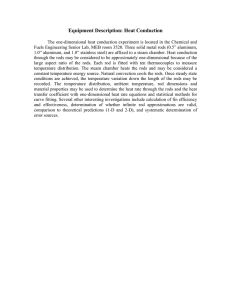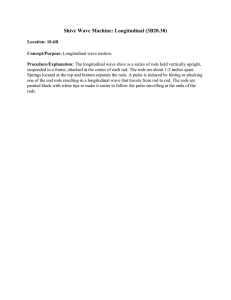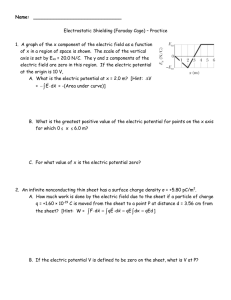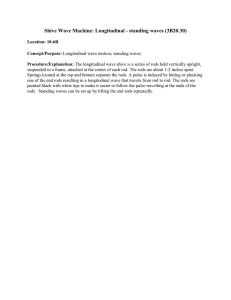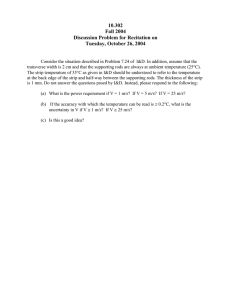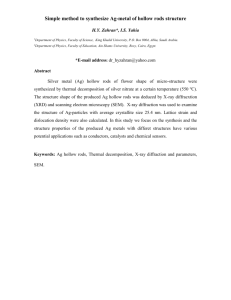Dynamic self-assembly of microscale rotors and swimmers
advertisement
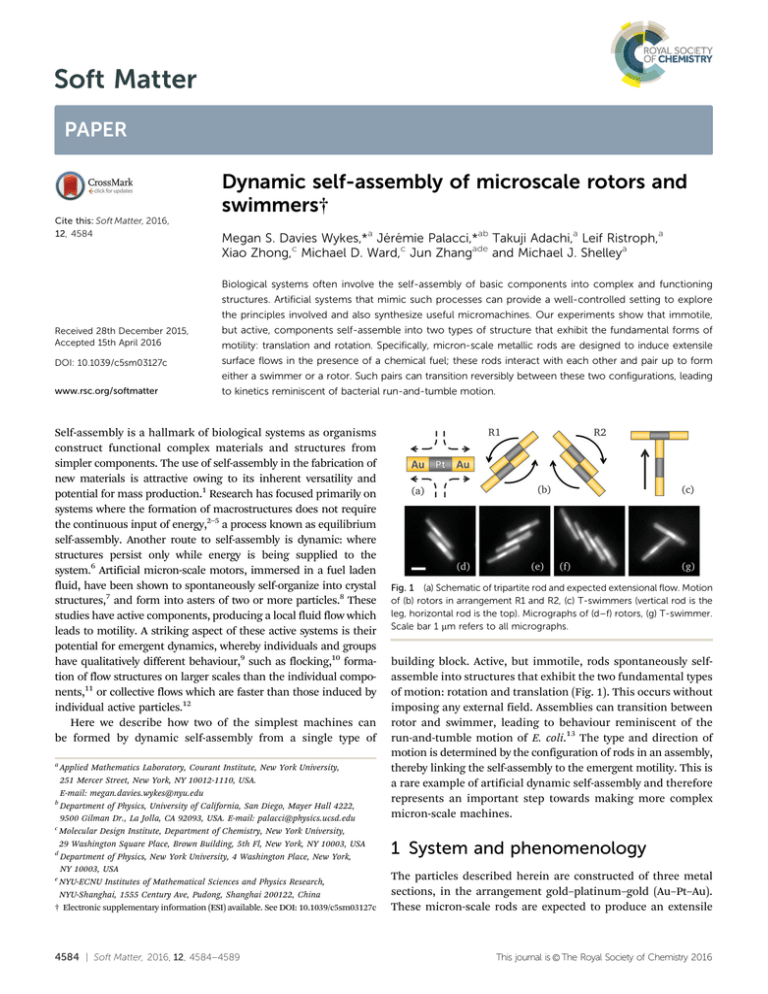
Soft Matter
PAPER
Cite this: Soft Matter, 2016,
12, 4584
Dynamic self-assembly of microscale rotors and
swimmers†
Megan S. Davies Wykes,*a Jérémie Palacci,*ab Takuji Adachi,a Leif Ristroph,a
Xiao Zhong,c Michael D. Ward,c Jun Zhangade and Michael J. Shelleya
Biological systems often involve the self-assembly of basic components into complex and functioning
structures. Artificial systems that mimic such processes can provide a well-controlled setting to explore
the principles involved and also synthesize useful micromachines. Our experiments show that immotile,
Received 28th December 2015,
Accepted 15th April 2016
but active, components self-assemble into two types of structure that exhibit the fundamental forms of
DOI: 10.1039/c5sm03127c
surface flows in the presence of a chemical fuel; these rods interact with each other and pair up to form
motility: translation and rotation. Specifically, micron-scale metallic rods are designed to induce extensile
either a swimmer or a rotor. Such pairs can transition reversibly between these two configurations, leading
www.rsc.org/softmatter
to kinetics reminiscent of bacterial run-and-tumble motion.
Self-assembly is a hallmark of biological systems as organisms
construct functional complex materials and structures from
simpler components. The use of self-assembly in the fabrication of
new materials is attractive owing to its inherent versatility and
potential for mass production.1 Research has focused primarily on
systems where the formation of macrostructures does not require
the continuous input of energy,2–5 a process known as equilibrium
self-assembly. Another route to self-assembly is dynamic: where
structures persist only while energy is being supplied to the
system.6 Artificial micron-scale motors, immersed in a fuel laden
fluid, have been shown to spontaneously self-organize into crystal
structures,7 and form into asters of two or more particles.8 These
studies have active components, producing a local fluid flow which
leads to motility. A striking aspect of these active systems is their
potential for emergent dynamics, whereby individuals and groups
have qualitatively different behaviour,9 such as flocking,10 formation of flow structures on larger scales than the individual components,11 or collective flows which are faster than those induced by
individual active particles.12
Here we describe how two of the simplest machines can
be formed by dynamic self-assembly from a single type of
a
Applied Mathematics Laboratory, Courant Institute, New York University,
251 Mercer Street, New York, NY 10012-1110, USA.
E-mail: megan.davies.wykes@nyu.edu
b
Department of Physics, University of California, San Diego, Mayer Hall 4222,
9500 Gilman Dr., La Jolla, CA 92093, USA. E-mail: palacci@physics.ucsd.edu
c
Molecular Design Institute, Department of Chemistry, New York University,
29 Washington Square Place, Brown Building, 5th Fl, New York, NY 10003, USA
d
Department of Physics, New York University, 4 Washington Place, New York,
NY 10003, USA
e
NYU-ECNU Institutes of Mathematical Sciences and Physics Research,
NYU-Shanghai, 1555 Century Ave, Pudong, Shanghai 200122, China
† Electronic supplementary information (ESI) available. See DOI: 10.1039/c5sm03127c
4584 | Soft Matter, 2016, 12, 4584--4589
Fig. 1 (a) Schematic of tripartite rod and expected extensional flow. Motion
of (b) rotors in arrangement R1 and R2, (c) T-swimmers (vertical rod is the
leg, horizontal rod is the top). Micrographs of (d–f) rotors, (g) T-swimmer.
Scale bar 1 mm refers to all micrographs.
building block. Active, but immotile, rods spontaneously selfassemble into structures that exhibit the two fundamental types
of motion: rotation and translation (Fig. 1). This occurs without
imposing any external field. Assemblies can transition between
rotor and swimmer, leading to behaviour reminiscent of the
run-and-tumble motion of E. coli.13 The type and direction of
motion is determined by the configuration of rods in an assembly,
thereby linking the self-assembly to the emergent motility. This is
a rare example of artificial dynamic self-assembly and therefore
represents an important step towards making more complex
micron-scale machines.
1 System and phenomenology
The particles described herein are constructed of three metal
sections, in the arrangement gold–platinum–gold (Au–Pt–Au).
These micron-scale rods are expected to produce an extensile
This journal is © The Royal Society of Chemistry 2016
Paper
flow when submerged in a solution of chemical fuel (Fig. 1a).
These particles are ‘active’ in that they generate a flow, but are
immotile as this flow is symmetric and asymmetric motion is
required to swim at low Reynolds number. Although many
studies have examined self-assembly for motile particles, there
have been few experimental studies on the self-assembly of active,
but immotile particles. A very recent report by Jewell et al.,
submitted to this journal nearly simultaneously with this article,
demonstrated that tripartite rods made from ruthenium and gold
segments (in the arrangements Ru–Au–Ru and Au–Ru–Au)
could self-assemble into various configurations.14 The report
by Jewell, et al. does not describe the motility of these particles,
and is complementary to the results described herein. Experiments
of silver nanorods surrounded by contractile flows (the reverse of
those studied here), induced by an external electric field that also
aligns the nanorods, have found evidence of hydrodynamic pair
interactions.15 Theoretical studies of ‘extensors’ have indicated the
presence of interesting collective behaviour.16,17 In the case of
individually immotile particles, motility itself can be a signature
of emergent dynamics as it indicates some form of symmetry
breaking in the system.
The system described here builds on research into micronscale bipartite gold–platinum (Au–Pt) rods, which swim by selfelectrophoresis when placed in a solution of hydrogen peroxide
(H2O2) fuel.18–24 Electrochemical decomposition of H2O2 results
in a gradient in proton concentration, which corresponds to an
electric field pointing from Pt to Au.25 The rods themselves have
an overall negative charge. Therefore, the positively charged
electrical double layer surrounding the rod experiences a force
due to the self-generated electrical field.24–26 A fluid flow develops
on the rod surface, from Pt to Au, causing the rod to swim with its
Pt end leading. Swimming rods have been observed to form pairs
transiently,27 suggesting the presence of attractive interactions.
The composition of particles can be tailored, thereby altering the
flow configuration around a rod.
Tripartite rods of length 2.18 0.4 mm and diameter
0.34 0.08 mm are fabricated as described in the ESI† (see
Fig. 1a). The motion of these particles on a glass coverslip is
observed using an inverted optical microscope, with a 100
objective (oil immersion, N.A. 1.4) and diascopic illumination.
The particles are dense compared to the solution and in experiments they settle and are essentially confined to 2D motions
along the lower surface of the chamber. There will be a hydrodynamic interaction between the rod and the wall. Although
models exist for this interaction, it is still an open area of
research.20,28,29 Our previous study of bipartite metallic rods
argued, using lubrication theory, for a hydrodynamic attraction
between motile active rods and walls.20 Reflected illumination
can be used to identify the individual metal segments (Fig. 1d–g).
When these tripartite rods are placed in a solution of H2O2 they
spontaneously self-assemble into several distinct configurations
(Fig. 1b–g).
The attraction between rods appears short-ranged, on the
order of a rod length, as further separated rods appear to act
diffusively. The most common assembly consists of two or more
parallel and regularly staggered rods, as seen in Fig. 1d–f and 3a.
This journal is © The Royal Society of Chemistry 2016
Soft Matter
Fig. 2 Rotor which changes direction (blue, dashed) and a rotor that has a
rod added to it (red, orange): the rotor begins with two rods (orange),
separates and re-forms with three rods (red). The three-rod assembly is
initially in a staggered arrangement (red, dotted), then adjusts to become a
three-rod rotor (red, solid), then loses a rod, becoming a two-rod rotor
(orange). Plotted are (a) the total number of rotations y/2p (winding number),
(b) the rotation rate, o/2p (Hz). Counter-clockwise is positive.
Rotors were most commonly composed of two or three rods, but
up to seven rod rotors were also observed (see ESI,† Fig. S1d).
Stable rotors assembled from more than two rods nearly always
show a staircase arrangement. An example of rotor self-assembly
is included as ESI,† Movie S1. Once assembled, these structures
rotate at a steady rate and in a direction determined by the rod
configuration (Fig. 1b and 2). As the rods are dense compared
to the solution, they are essentially confined to 2D and consequently rotor geometries are chiral. There are two observed
arrangements, referred to as R1 and R2, as illustrated by Fig. 1b.
Rotors always rotate with the outer rod leading, i.e. R1 rotates
counter-clockwise and R2 rotates clockwise. Individual rotors
have mean rotation rates in the range o = 0.4–2 Hz for 3% H2O2
(ESI†). While some rotors breakup after short times (B10 s),
others persist without breakup for longer than the recording
time of experiments (4120 s) and are sufficiently stable to
survive collisions with other rods.
Assembly is generally reversible – pairs can separate and
re-form – and the reassembled structures rotate at an identical
speed and in the same direction, if reassembled in the original
configuration. In Fig. 2a (dashed line) an example is shown
where a rotor begins in configuration R1, rotating counterclockwise (defined as positive). At 30 s, thermal fluctuations
cause the rods within a rotor to break apart. When the rotor
reforms, it has switched to configuration R2 and starts rotating
in a clockwise direction. At 40 s, the rotor breaks apart a second
time, returning to the original R1 configuration and again
rotating counter-clockwise. The rotation speed of this example
is plotted in Fig. 2b (dashed line) and is equal to 1 Hz when
rotating counter-clockwise and 0.5 Hz when rotating clockwise.
Many rotors rotate at identical speeds even after a change of
direction. An example of a rotor changing direction is included
as Movie S2 (ESI†). Rods can be added to existing rotors,
Soft Matter, 2016, 12, 4584--4589 | 4585
Soft Matter
creating yet larger rotating aggregates (Fig. 1e and f). When a
rod is added to a rotor this results in a small change in rotation
rate. An example of this is shown in Fig. 2, where a rotor
initially composed of two rods (orange) has a rod added to it
(red). Initially the three-rod assembly is in a staggered arrangement (red, dotted), but then adjusts to become a three-rod rotor
(red, solid). At a later time, the assembly separates back to a
two-rod rotor (orange). An example of a rod being added to a
rotor is included as Movie S3 (ESI†). The staggered arrangement
that appears as an intermediary state is less common than the
staircase arrangements seen in rotors.
Another self-assembled structure is the T-swimmer, consisting
of two perpendicular rods joined by a Pt–Au junction, which
swims in a direction aligned with the leg of the ‘T’, towards the
end with the junction (Fig. 1c and 3b). An example can be seen in
Movie S4 (ESI†). This shape is much less common than the rotors,
accounting for only B5% of assemblies. T-swimmers persist for
shorter times than rotors (B10 s) and are often a transitional state
when a rotor reverses direction or otherwise breaks alignment (as
in Movie S2, ESI†). When a rotor and a T-swimmer collide a variety
of events can happen. The rotor tends to stay a rotor, but the rods
that make up the T-swimmer can become part of the rotor, or
continue as a T-swimmer, or become a separate rotor, or break
apart to become single rods. All of these have been observed and a
movie illustrating the interactions of T-swimmers with rotors is
included as ESI,† Movie S6. Interestingly, pairs can transition
repeatedly between the T-swimmer and rotor configurations. As a
T-swimmer, the pair swims in looping trajectories, as seen in
Fig. 4d, while a rotor essentially spins in place. Fig. 3c shows the
trajectory of a particle pair that starts as a T-swimmer, transitions
into a rotor, and then returns to the T-swimmer configuration (see
Movie S5, ESI†). Switching between the two states is most likely a
result of thermal fluctuations, which is consistent with the time
spent either as a rotor or a swimmer being apparently randomly
distributed. Rotation for a random length of time will cause the
swimming direction to be randomised when the pair switches
back to a T-swimmer. These characteristics make the dynamics of
a particle pair that is persistently switching between states reminiscent of bacterial run-and-tumble behaviour.
Paper
2 Analysing the emergent dynamics
We have stated that individual rods appear to act diffusively
and assemblies show motility. In the following section we use a
model to demonstrate the change in behaviour between single
rods and assemblies. We model the dynamics using overdamped
Langevin equations for the path (x,y) and angle y of particle:30,31
pffiffiffiffiffiffiffi
dxðtÞ
¼ v cosðyðtÞÞ þ 2Dxx ðtÞ;
dt
(1)
pffiffiffiffiffiffiffi
dyðtÞ
¼ v sinðyðtÞÞ þ 2Dxy ðtÞ;
dt
(2)
pffiffiffiffiffiffiffiffi
dyðtÞ
¼ o þ 2Dr ZðtÞ:
dt
(3)
Here v is the speed of the particle, o is its rotation rate in
rad s1, D is the translational diffusion coefficient and Dr is the
rotational diffusion coefficient. The noise terms xx, xy and Z are
uncorrelated Gaussian processes with zero mean and unit
variance.31,32 We have approximated the diffusion of rods and
assembled structures as isotropic,23,33 which is sufficient to
demonstrate the difference in behaviour between single rods
and assemblies, although descriptions that include the effects
of anisotropic diffusion have also been studied.34–36
Eqn (3) is decoupled from eqn (1 and 2) and can be integrated
to give the mean-squared angular displacement (MSAD)
hDy(t)2i = o2t2 + 2Drt
2
where Dy(t) = (y(t0 + t) y(t0)) and h i indicates an average over
a time series. Eqn (4) shows that deterministic rotation results in
a quadratic MSAD, whereas rotational diffusion results in a
linear MSAD.31–33
The tracks of a rotor (blue) and the component rods after
breakup (red, orange) are each plotted for 10 s in Fig. 4a. The
MSAD reveals the fundamentally different dynamics of a pair
compared to a single rod (Fig. 4b). The rotation of individual
rods is diffusive, but when assembled into a rotor the MSAD is
quadratic with time, characteristic of deterministic rotation. The
MSAD for several rotors and single rods are plotted in Fig. 4c.
The motion of rotors is dominated by deterministic rotation,
while the motion of the majority of single rods is diffusive.
Solving eqn (1–3) to find the mean-squared displacement
(MSD) reveals the existence of several regimes.33 For t { 1/Dr
and t { 1/o, the MSD takes the limiting form of
hDR(t)2i = 4Dt + v2t2
Fig. 3 Overlay images of (a) rotor, time interval: 0.5 s, (b) T-swimmer, time
interval: 1 s. Scale bars 1 mm. (c) Path taken by a pair of rods transitioning
from T-swimmer, to rotor, to T-swimmer (scale bar refers to path, overlay
images at 21 scale). Overlay images at t = 0, 1.6, 4.4, 5, and 7.2 seconds.
4586 | Soft Matter, 2016, 12, 4584--4589
(4)
2
(5)
showing that locomotion results in a MSD that is quadratic in
time.30 The trajectories of a T-swimmer and its component rods
are each plotted for 10 s in Fig. 4d. The MSD shows dramatically enhanced swimming when the rods are assembled into a
T-swimmer (Fig. 4e). Comparing the MSD for several single
rods and T-swimmers (Fig. 4f), it appears that individual rods
have a spectrum of behaviours: many are diffusive, but some
are swimming, which could be due to asymmetries in the rods.
The nearly quadratic MSD of T-swimmers indicates a component of deterministic translation, while the change in gradient
This journal is © The Royal Society of Chemistry 2016
Paper
Soft Matter
Fig. 4 Dynamics of a rotor and a T-swimmer: (a) tracks of rotor (blue) and component rods after breakup (orange, red) plotted for 10 s. (b) MSAD (rad2 s2)
for rotors and rods from (a). (c) MSAD (normalised by maximum value) for 40 rotors (blue) and 29 single rods (orange). (d) Tracks of T-swimmer (blue) and
component rods after breakup (orange, red) plotted for 10 s. (e) MSD (mm2 s2) for T-swimmer and rods from (d). (f) MSD (normalised by maximum value)
against time for 3 T-swimmers (blue) and 33 single rods (orange). The majority of single rods have slightly super-diffusive translation and rotation, consistent
with slight motility. Rotor MSAD shows a quadratic dependence on time, characteristic of powered rotation. T-swimmers show a mix of translational
diffusion and powered translation. Overlaid micrographs on (a and d) are to scale with particle tracks.
in Fig. 4f shows that the deterministic component 4Dt is of a
similar magnitude to v2t2 for this time.
Fitting eqn (4) to the MSAD allows the measurement of o
and Dr, while fitting the solution of eqn (1–3) to the MSD allows
the measurement of v and D.33 Estimates of Dr are in agreement
with previous work.37 An effective long-time diffusion coefficient
can be calculated analytically from eqn (1–3), as
Deff ¼ D þ
v2 Dr
;
2ðDr2 þ o2 Þ
(6)
indicating an enhanced diffusivity from motility, with this enhancement lessened by rotation.33 Interestingly, measured rotor values of
Deff are in general smaller than those measured for single rods
without fuel and decreases with the number of rods in a rotor. This
might be expected as rotors are longer than single rods, which
reduces D.37 The smaller Deff does not indicate that v = 0, as the
enhancement of the translational diffusion is reduced by rotation
and is negligible if 9v2 { 2L2(Dr2 + o2).37 In fact, rotors move in
circular orbits, indicating that v a 0. The distribution of radii of
these orbits is of the same order of magnitude as the distribution
of rod lengths, suggesting that the non-zero v is due to variations
in the rods.
expected to generate a contractile flow, the reverse of Fig. 1a.
Parallel pairs were not observed to form. This suggests that
hydrodynamic attraction is important for bringing the rods into
maximal proximity, revealing the importance of the design of
the rods for the self-assembly.
The detailed configuration of assemblies is influenced by
additional effects. In particular, rotors exhibit a measurable
and robust offset between the centres of the constituent rods,
as seen in Fig. 1d–f. This observation is quantified by examining
the magnitude of the offset d between the centroids of paired
rods in a rotor (Fig. 5, inset) and measuring its variation in time.
The fractional residence time tR is the time spent at a particular
offset as a proportion of the total time of an experiment. We plot
log(tR) in Fig. 5 as, in an analogy with an equilibrium system,
the energy of a state E(d)B log(tR). The black curve reveals a
minimum centred at d E L/3, giving a preferred overlap that
places the Pt and Au segments of each rod into close proximity.
3 Self-assembly
The assembly of rods may be influenced by many physical
effects, including hydrodynamic, electric, thermal and steric
interactions. For the extensile rods studied here, simulations
indicate that hydrodynamics alone is sufficient to bring together
pairs of parallel rods.17 To examine the effect of the flow surrounding the rod, experiments were conducted using rods of the alternative configuration, Pt–Au–Pt (not shown). These particles are
This journal is © The Royal Society of Chemistry 2016
Fig. 5 The pseudopotential log(tR) as a function of rotor offset d/L, where
tR is the fractional residence time or probability of an offset. An offset of
d E L/3 (see inset) is most prevalent at the lowest conductivity, which
corresponds to no added salt. Adding salt increases conductivity, k, and
leads to a broader distribution of offsets. As only the magnitude of d is
measured, log(tR) is reflected about d = 0.
Soft Matter, 2016, 12, 4584--4589 | 4587
Soft Matter
This suggests that electro-kinetic effects play an important role
in determining the configuration. Simulations by Jewell et al.
suggest that the 1/3 offset minimizes the electrostatic repulsion
between the rods that make up a rotor.14
These observations suggest that self-assembly is driven by both
hydrodynamic and electro-kinetic interactions, which together
compete against thermal effects. Changing the conductivity of
the solution by the addition of sodium chloride salt (NaCl),
weakens both the electro-kinetic and hydrodynamic interactions,
thus varying the relative importance of these effects. Specifically,
changing the conductivity exerts three main effects: (i) The electric
field strength E in the solution has an inverse relationship with
conductivity k by Ohm’s law, E = i/k, where i is the ion flux;38 (ii) The
swimming speed of bipartite swimmers has an inverse relationship
to solution conductivity U B 1/k, where U is the swimming speed39
and a similar relationship for the flow around the tripartite rods
would be expected; (iii) The length scale l of the near-surface region
where flow and electric field occur, scales as l B 1/k.
Due to the weakened interactions, it is expected that the
offset between rods will be more widely distributed. Experiments
were conducted at 5% H2O2 and four values of the conductivity
(corresponding to NaCl concentrations of 0, 0.17, 0.44, and
0.87 mM), again measuring the variation in the magnitude of d,
here by examining the change in overall perimeter of a rotor over
time (ESI†). The results are plotted as pseudopotentials in Fig. 5,
where the black curve corresponds to no added salt. Increasing
the conductivity results in the component rods sliding parallel to
each other, causing large variations in d over time and thus a
more uniformly distributed pseudopotential. At high conductivities, an offset of zero is most energetically favourable. The
simulations of Jewell et al. show that this totally overlapped
state is hydro-dynamically favourable.14
4 Discussion
The formation of both rotors and T-swimmers from symmetric
active particles has also been reported in computational simulations
of filaments constructed of active beads producing force-free, torquefree flows in a fluid, confined to move in 2D in an infinite domain.17
Filaments surrounded by an overall extensile flow (globally similar to
what is expected for the rods studied here) formed into parallel pairs
which rotate, but in the opposite direction to that which is observed
in our experiments (i.e. in these simulations R1 would rotate clockwise, R2 counter-clockwise). The formation of T-swimmers was also
predicted by these simulations, but for component filaments surrounded by contractile flows.17 In contrast, the T-swimmers in our
experiments were formed from rods inducing extensile flows in their
surroundings and ordered assemblies were not observed to form in
experiments using rods with contractile flows.
The motion of rotors and T-swimmers might be explained by
considering the extensile outer fluid flows that are created by
these structures. In the case of rotors, the combination of the
offset between the rods and the extensile outer flow fields would
result in rotation in the observed direction. Likewise, the net
result of the extensile outer flows around a T-swimmer is to pump
4588 | Soft Matter, 2016, 12, 4584--4589
Paper
fluid against and from the top of a T-swimmer down the leg,
causing the T-swimmer to swim with the top leading, as observed.
This is a general argument that would predict the observed
motion for offset rotors and T-swimmers, assembled from any
rods which are surrounded by extensile flows, so long as the outer
flow is left essentially unchanged when the rods assemble into
rotors and T-swimmers. The possibility of an additional mechanism for the motion of rotors and T-swimmers exists for these
tripartite Au–Pt–Au particles, as there is the potential for electrical
interactions between adjacent rods. If the overlapped Pt and Au
segments of rods within a rotor can pump fluid from Pt to Au,
then a rotor can be conceived as two anti-parallel swimmers, and
would result in the observed rotation. Similarly, an electrically
induced flow across the Pt–Au junction in the T-swimmer would
explain its direction of motion. Either or both of these mechanisms would explain the observed motion.
We have described the dynamic and reversible self-assembly of
rotors and T-swimmers from symmetric, tripartite Au–Pt–Au micronscale rods. Self-assembly breaks the symmetry of individual particles,
leading to directed motion. In the case of rotors, the symmetry is
broken because of a misalignment of the rods, presumably due to
the electrical interactions, as quantified by the energy landscape of
Fig. 5. This system has rich dynamics, resulting from the complex
interplay of various forces, with the potential for control over the
rotation rate, swimming velocity and lifetime of assembled structures through the fuel concentration, solution conductivity and
tailoring of particle geometry and composition. This is a rare
example of artificial dynamic self-assembly, a process common in
nature. Systems of this type are of interest not only because of
potential applications in micro-fluidics but also because a more
detailed understanding of dynamic self-assembly could lead to
insights about similar processes in nature.
Acknowledgements
We thank Marjorie Lopez, of the University of Puerto Rico, for
playing a key role in setting up the process for synthesizing nanorods at the Department of Chemistry, New York University, as part
of the REU program. We also thank Y. Liu, A. Hollingsworth and
M. Driscoll for useful conversations. This work was primarily
supported by the Materials Research Science and Engineering
Center (MRSEC) program of the National Science Foundation
under Award Number DMR-1420073. M. S. D. W. thanks the
Fulbright Scholarship Lloyds of London Award for financial support. T. A. thanks the JSPS Postdoctoral Fellowships for Research
Abroad for the financial support. This article is based on work
presented at the APS/DFD meeting in 2015, in session L39.00008
‘‘Dynamic self-assembly of microscale rotors and swimmers’’.
References
1 G. M. Whitesides and B. Grzybowski, Science, 2002, 295,
2418–2422.
2 J. Zhang, E. Luijten and S. Granick, Annu. Rev. Phys. Chem.,
2014, 66, 581–600.
This journal is © The Royal Society of Chemistry 2016
Paper
3 S. Sacanna, W. T. M. Irvine, P. M. Chaikin and D. Pine,
Nature, 2010, 464, 575–578.
4 Q. Chen, S. C. Bae and S. Granick, Nature, 2011, 469,
381–384.
5 Y. Wang, Y. Wang, D. R. Breed, V. N. Manoharan, L. Feng,
A. D. Hollingsworth, M. Weck and D. Pine, Nature, 2012,
490, 51–55.
6 W. Wang, W. Duan, S. Ahmed, A. Sen and T. E. Mallouk,
Acc. Chem. Res., 2015, 48, 1938–1946.
7 J. Palacci, S. Sacanna, A. P. Steinberg, D. Pine and P. M.
Chaikin, Science, 2013, 339, 936–940.
8 S. Ahmed, D. T. Gentekos, C. A. Fink, T. E. Mallouk and
A. E. T. Al, ACS Nano, 2014, 8, 11053–11060.
9 D. Saintillan and M. J. Shelley, C. R. Phys., 2013, 14, 497–517.
10 A. Bricard, J.-B. Caussin, N. Desreumaux, O. Dauchot and
D. Bartolo, Nature, 2013, 503, 95–98.
11 T. Sanchez, D. T. N. Chen, S. J. DeCamp, M. Heymann and
Z. Dogic, Nature, 2012, 491, 431–434.
12 D. Saintillan and M. J. Shelley, J. R. Soc., Interface, 2012, 9,
571–585.
13 H. C. Berg and R. M. Berry, Phys. Today, 2005, 58, 64–65.
14 E. L. Jewell, W. Wang and T. E. Mallouk, Soft Matter, 2016,
12, 2501–2504.
15 K. a. Rose, B. Hoffman, D. Saintillan, E. S. G. Shaqfeh and
J. G. Santiago, Phys. Rev. E: Stat., Nonlinear, Soft Matter Phys.,
2009, 79, 011402.
16 D. Saintillan and M. J. Shelley, Phys. Rev. Lett., 2007,
99, 058102.
17 A. Pandey, P. B. S. Kumar and R. Adhikari, arXiv:cond-mat.soft,
2014.
18 W. F. Paxton, K. C. Kistler, C. C. Olmeda, A. Sen, S. K. St. Angelo,
Y. Cao, T. E. Mallouk, P. E. Lammert and V. H. Crespi, J. Am.
Chem. Soc., 2004, 126, 13424–13431.
19 Y. Wang, R. M. Hernandez, D. J. Bartlett, J. M. Bingham,
T. R. Kline, A. Sen and T. E. Mallouk, Langmuir, 2006, 22,
10451–10456.
20 D. Takagi, J. Palacci, A. B. Braunschweig, M. J. Shelley and
J. Zhang, Soft Matter, 2014, 10, 1784–1789.
This journal is © The Royal Society of Chemistry 2016
Soft Matter
21 Y. Wang, S. T. Fei, Y. M. Byun, P. E. Lammert, V. H. Crespi,
A. Sen and T. E. Mallouk, J. Am. Chem. Soc., 2009, 131,
9926–9927.
22 S. J. Ebbens and J. R. Howse, Soft Matter, 2010, 6, 726–738.
23 D. Takagi, A. B. Braunschweig, J. Zhang and M. J. Shelley,
Phys. Rev. Lett., 2013, 110, 038301.
24 J. L. Moran, P. M. Wheat and J. D. Posner, Phys. Rev. E: Stat.,
Nonlinear, Soft Matter Phys., 2010, 81, 065302.
25 W. Wang, T. Y. Chiang, D. Velegol and T. E. Mallouk, J. Am.
Chem. Soc., 2013, 135, 10557–10565.
26 J. L. Moran and J. D. Posner, J. Fluid Mech., 2011, 680, 31–66.
27 W. Wang, W. Duan, A. Sen and T. E. Mallouk, Proc. Natl.
Acad. Sci. U. S. A., 2013, 110, 17744–17749.
28 S. E. Spagnolie, G. R. Moreno-Flores, D. Bartolo and E. Lauga,
Soft Matter, 2015, 11, 3396–3411.
29 A. P. Berke, L. Turner, H. C. Berg and E. Lauga, Phys. Rev.
Lett., 2008, 101, 1–4.
30 J. R. Howse, R. A. L. Jones, A. J. Ryan, T. Gough, R. Vafabakhsh
and R. Golestanian, Phys. Rev. Lett., 2007, 99, 048102.
31 S. van Teeffelen and H. Löwen, Phys. Rev. E: Stat., Nonlinear,
Soft Matter Phys., 2008, 78, 020101.
32 N. A. Marine, P. M. Wheat, J. Ault and J. D. Posner, Phys. Rev. E:
Stat., Nonlinear, Soft Matter Phys., 2013, 87, 052305.
33 S. J. Ebbens, R. A. L. Jones, A. J. Ryan, R. Golestanian and
J. R. Howse, Phys. Rev. E: Stat., Nonlinear, Soft Matter Phys.,
2010, 82, 015304.
34 Y. Han, A. Alsayed, M. Nobili, J. Zhang, T. C. Lubensky and
A. G. Yodh, Science, 2006, 314, 626–630.
35 B. ten Hagen, S. van Teeffelen and H. Löwen, J. Phys.:
Condens. Matter, 2011, 23, 194119.
36 F. Kümmel, B. Ten Hagen, R. Wittkowski, I. Buttinoni,
R. Eichhorn, G. Volpe, H. Löwen and C. Bechinger, Phys.
Rev. Lett., 2013, 110, 1–5.
37 M. Doi and S. F. Edwards, The theory of polymer dynamics,
Oxford University Press, 1986.
38 W. F. Paxton, P. T. Baker, T. R. Kline, Y. Wang, T. E. Mallouk
and A. Sen, J. Am. Chem. Soc., 2006, 128, 14881–14888.
39 J. L. Moran and J. D. Posner, Phys. Fluids, 2014, 26, 042001.
Soft Matter, 2016, 12, 4584--4589 | 4589
